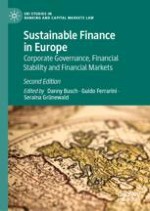This second edition brings together the views of expert academics and practitioners on the latest regulatory developments in sustainable finance in Europe and includes 5 new chapters on sustainable remuneration, reporting, lending, green monetary policy and ESG. The volume includes a wide range of cutting-edge issues, which relate to three main themes along which the volume is structured: (1) corporate governance; (2) monetary policy and financial stability ; and (3) financial markets. With individual contributions deploying different methods of analysis, including theoretical contributions on the status quo of macro-financial research as well as law and economics approaches, the collection encourages interdisciplinary readership and will appeal to those researching capital markets law, European financial law, and sustainable finance, as well as practitioners within the finance industry.
